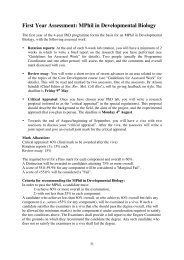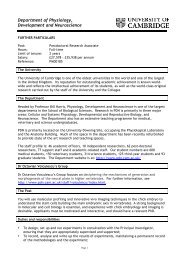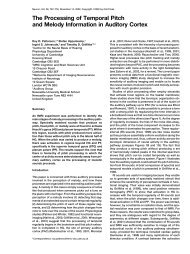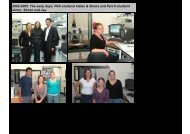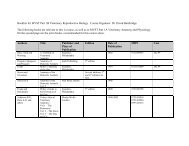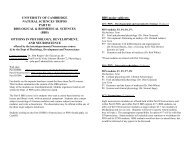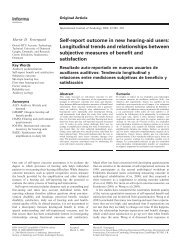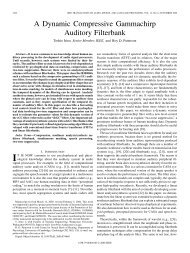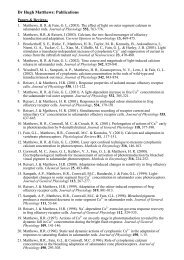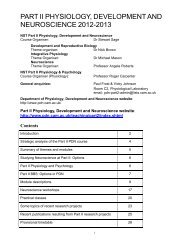FRIDAY MORNING, 20 MAY 2005 REGENCY E, 8:30 A.M. TO 12:00 ...
FRIDAY MORNING, 20 MAY 2005 REGENCY E, 8:30 A.M. TO 12:00 ...
FRIDAY MORNING, 20 MAY 2005 REGENCY E, 8:30 A.M. TO 12:00 ...
Create successful ePaper yourself
Turn your PDF publications into a flip-book with our unique Google optimized e-Paper software.
esults showed that these sum and difference combinations created deformation<br />
patterns with nearly the same variation along the vocal tract length<br />
as the basis functions derived from articulatory data. The procedure was<br />
then applied to other speaker-specific sets of area functions and the results<br />
were similar. Work supported by NIH R01-DC04789.<br />
5pSC15. The effect of spatial frequency information in central and<br />
peripheral vision on natural gaze patterns and audiovisual speech<br />
perception. Julie N. Buchan, Amanda Wilson, Martin Paré, and Kevin<br />
G. Munhall Queen’s Univ., Kingston, ON, Canada,<br />
2jnb@qlink.queensu.ca<br />
It has been known for some time that visual information plays an<br />
important role in how we perceive speech. The present research examines<br />
how this visual information is processed in central and peripheral vision.<br />
The perception of visual images is carried out in the nervous system by a<br />
set of spatial frequency-tuned channels and the sensitivity to spatial resolution<br />
varies across the retina. The experiment was conducted using a<br />
gaze-contingent display system that records a person’s eye position and<br />
then displays different information to their peripheral and central vision.<br />
The amount of high spatial frequency information presented in the central<br />
and peripheral visual fields was manipulated and the effect on both audiovisual<br />
speech perception and natural gaze patterns was measured. Preliminary<br />
results show that when peripheral information is no longer adequate,<br />
gaze patterns become altered to gather important visual information. This<br />
suggests that information across the whole visual field influences audiovisual<br />
speech behavior.<br />
5pSC16. Perception of a Japanese moraic obstruent in an<br />
identification task. Shigeaki Amano, Ryoko Mugitani, and Tessei<br />
Kobayashi NTT Commun. Sci. Labs., NTT Corp., 2-4 Hikari-dai,<br />
Seika-cho, Souraku-gun, Kyoto 6190237, Japan<br />
Native Japanese speakers perceive a moraic obstruent when the closure<br />
duration between successive moras is longer than a normal obstruent.<br />
However, it has not been well clarified how the perception of the moraic<br />
obstruent relates to the closure and neighboring moras’ duration. To investigate<br />
this point, a perceptual experiment was conducted with stimuli consisting<br />
of two-mora nonsense syllables with a closure between the moras<br />
/bipa/, /guku/, /kuku/, /kuto/, and /tapi/. The closure duration was shortened<br />
or lengthened in 10-ms steps. The duration of the first mora was<br />
modified by changing its vowel duration to 50%, 1<strong>00</strong>%, and 150% by the<br />
STRAIGHT method. Forty native Japanese speakers identified whether the<br />
nonsense syllable contained a moraic obstruent with the 2AFC method.<br />
Results showed that the perceptual boundaries of the moraic obstruent<br />
were 182 ms (SD13.2 ms), <strong>20</strong>4 ms (SD14.7 ms), and 222 ms (SD<br />
16.6 ms), respectively, with 50%, 1<strong>00</strong>%, and 150% vowel durations in<br />
the first mora, and that a logistic function fits the identification ratio very<br />
well. The results indicated that the perception of a moraic obstruent depends<br />
on both closure duration and the duration of neighboring moras.<br />
They also suggest that the perception would be categorical.<br />
5pSC17. Nasals and nasalization: The interplay between segmental<br />
duration and coarticulation. Samantha E. Sefton and Patrice S. Beddor<br />
Dept. of Linguist., Univ. of Michigan, 4080 Frieze Bldg., Ann Arbor, MI<br />
48109, beddor@umich.edu<br />
Two experiments were conducted on English to test the hypothesis that<br />
the temporal extent of coarticulatory nasalization is inversely related to the<br />
duration of the source of coarticulation. Experiment 1 investigated patterns<br />
of carryover NVC and anticipatory CVN vowel nasalization, and the<br />
overall timing of nasalization across the syllable. Acoustic analysis of<br />
CVN and NVC words e.g., seen/niece, pin/nip, tame/mate, ten/net produced<br />
by five speakers showed that, although vowel nasalization is temporally<br />
more extensive in CVN than in NVC sequences, N is shorter in<br />
CVN than in NVC, so that there was no significant overall difference in<br />
total nasalization between the two syllable types. Experiment 2 tested<br />
similar timing patterns in CVNC syllables, where N duration varied as a<br />
function of the voicing of the following C e.g., wince/wins, sent/send,<br />
can’t/canned. Acoustic measures of productions of five English speakers<br />
again showed that the shorter the N, the temporally more extensive the<br />
vowel nasalization. Findings for selected other languages Thai, Italian<br />
provide further evidence of the inverse relation. These findings have implications<br />
for theories of coarticulation and theories of phonological<br />
change. Work supported by NSF.<br />
5pSC18. Perception of a Japanese moraic obstruent in a<br />
discrimination task. Tessei Kobayashi, Ryoko Mugitani, and Shigeaki<br />
Amano NTT Commun. Sci. Labs., NTT Corp., 2-4, Hikaridai,<br />
Seika-cho, Soraku-gun, Kyoto, Japan 619-0237<br />
Previous research with an identification task suggests that native Japanese<br />
speakers perceive a moraic obstruent categorically Amano et al.,<br />
<strong>20</strong>05. However, it is still unclear whether the suggestion would be confirmed<br />
by other tasks. This study used an AX discrimination task to investigate<br />
whether the performance is highly sensitive around the perceptual<br />
boundaries that were obtained from the identification task. Native Japanese<br />
speakers (N40) were presented with a pair of two-mora nonsense<br />
syllables /bipa/, /guku/, /kuku/, /kuto/ and then required to judge whether<br />
the stimulus pair was acoustically identical. The stimulus set was produced<br />
by reducing or increasing the closure duration between the successive<br />
moras in 5-ms steps (95 to 240 ms. Results showed that the participants<br />
discriminated more precisely around closures duration ranging from approximately<br />
150 to 180 ms /bipa/: 180 ms, /guku/: 160 ms, /kuku/: 155<br />
ms, /kuto/: 175 ms. Although the results indicate, to some degree, the<br />
possibility of perceptual categorization of the moraic obstruent, the high<br />
sensitivity peak in each stimulus type was slightly shifted from the perceptual<br />
boundaries in the identification task.<br />
5pSC19. Intrinsic factors of releasing motions in an articulator: On<br />
assuming segmental input in speech-production models. Victor J.<br />
Boucher Univ. of Montreal, C.P. 6<strong>12</strong>8 succ. Centre-ville, Montreal, QC,<br />
Canada J3C 3J7<br />
Prominent models of speech production use serial input that is assumed<br />
to be commensurate with linguistic segments. The view is that such<br />
units underlie a serial activation of aperture motions such as closing and<br />
opening motions of the lips in articulating a bilabial stop. This is incompatible<br />
with conventional EMG observations showing a single burst of<br />
activity of labial adductors at the onset of a close-open cycle. The present<br />
study examines the spring-like effects of bilabial compression and pressure<br />
on labial opening release following a relaxation of the orbicularis<br />
oris muscle. Using reiterative series papapapa produced at increasing<br />
intensities, the range and velocity of opening motions of the lower-lip<br />
were correlated with lip compression and oral-pressure. The results for<br />
three speakers show that pressure and compression are correlated and that<br />
these factors account for 45% to 66% of the variance in velocity of lowerlip<br />
opening, and for 47% to 73% of the variance in the range of lower-lip<br />
opening. These results complement earlier findings of Abbs and Eilenberg<br />
1976 showing the intrinsic effects of muscle elasticity on opening motions<br />
of the lips. Close-open cycles in articulators may not reflect segmentby-segment<br />
serial activation.<br />
5pSC<strong>20</strong>. Kinematic properties of stop and fricative production.<br />
Anders Lofqvist Haskins Labs., 270 Crown St., New Haven, CT 06511,<br />
lofquist@haskins.yale.edu<br />
This study examined movement kinematics in stop and fricative consonants,<br />
looking for potential evidence of different movement characteristics<br />
related to precision requirements. It has often been claimed that<br />
fricatives require more precision in their production than stops due to the<br />
management of airflow. However, the empirical evidence for this claim is<br />
26<strong>20</strong> J. Acoust. Soc. Am., Vol. 117, No. 4, Pt. 2, April <strong>20</strong>05 149th Meeting: Acoustical Society of America 26<strong>20</strong>



